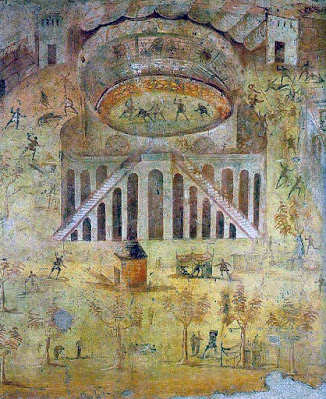Roman Amphitheatre of Uthina The Roman Amphitheatre of Uthina is located in Uthina , near Tunis, Tunisia . Building for Uthina began in 40 BC and continued through to 135 AD. The amphitheatre may have been a later addition to what was already a large town. Also located there were a fortress, cisterns, an aqueduct, a triumphal arch, a theatre, and a basilica with a circular crypt . Coordinates 36.608598,10.169214 Description The amphitheatre, partly buried, measures 113 by 90 meters. The arena measures 58 by 35 metres, giving surface areas of 7988 and 1539 square metres respectively. There are four entrances, two main entrances at each end, with the seating area supported by three tiers of columns and arches. (Although these are no longer there, measurements and amphitheater descriptions rely on a complete building.) Measurements for the amphitheatre on site are 12 0 by 89 metres, with the arena measuring 67 by 36 metres. The surface areas measure 10680 an d 24...
Amphitheatre Pompeii
The Amphitheatre of Pompeii is the oldest surviving Roman amphitheatre. It is situated in the ancient Roman city of Pompeii and was buried by the eruption of Vesuvius in 79 ad. It is located to the east of the city and the edge of the eruption.
It measures 135m long and 104m wide, the arena's pit is measured at 6m below ground level and was built in 70 bc.
Coordinates
40.751827,14.494962
Measurements
135m x 104m (341ft x 443ft)
76.2m x 38.1m (250ft x 125ft)
Angled at 60° towards northwest
Area
π×341×443=474578
π×250×125=98175
474578×98175=46591695150
46591695150÷223=208931368
π×341×450=482077
482077×98175=47327909475
47327909475÷223=212232777
Roman Units
The Roman cubit (cubitum) was 1½ Roman feet (17.48 inches)
Five Roman feet made the pace (passus), 1.48 metres (58.23 inches).
If considering a standardised unit, the Roman foot was probably used here, making the above whole units in 5's as if a passus. If applying again, the amphitheatre would measure at 340ft x 440ft Roman feet.
π×340×440=469982
469982×98175=46140482850
46140482850÷223=206907994
Like from the Amphitheatre Pozzuoli, these two different areas are multipled and divided by 223. This time they give a number of 206907994 which could be considered as Mars perihelion.
Mars perihelion
206700000 km
Conclusion
In ancient Roman religion and myth, Mars was the god of war and also an agricultural guardian, a combination characteristic of early Rome. Most festivals were held in March a month named after him.
Even though the Amphitheater Pozzuoli was built in 80 ad and the Amphitheatre Pompeii was built in 70 bc, they share the same design. At the same time as the construction of the Amphitheater Pozzuoli, the Colosseum in Rome was built, but it used a volume and area measurement that corresponded with the number of archs.
This is possible because there is a possibility that the design of the Colosseum was formulated in 25 bc.
Amphitheatre of Pompeii
Archeology77 ©
Amphitheatre of Pompeii
Archeology77 ©

Comments
Post a Comment